|
The Shape of the walk
Mark Surridge, in New Zealand,
reflects on his summer 2018 residency there.
If I draw a line around the globe from Cornwall in South West England to
Waiheke island I see the shape I have travelled. This inspirational line
has brought me to the other side of the world and this line continues in
‘The Shape of the Walk’ informing the start of my twelve week creative
journey as Artist in Residence on Waiheke Island.
My proposal for this residency was to make a series of paintings which
use GPS technology to map where I am on the Earth, to see what that
shape would look like from the beginning to the end of a walk as a
mapped line and to use this information as a starting point in the
studio to create some of the shapes and patterns in the paintings. This
is only one aspect of my creative process, I also consider multiple
viewpoints, peripheral vision and the feel and mood of the landscape. I
respond to the elemental qualities of nature. I am interested in the
ancient, the scars left behind on the surface of the land that are like
palimpsests. I value intuition and spontaneity in the studio, striving
for simplicity and the essence of my subject matter. The walk is merely
the starting point for making the work in the studio.
One of the first walks that I encountered was located on the south
westerly point of the island starting from Walter Frank Road, via Te
Wharau Bay and around Park Point and towards Cable Bay. The terrain was
very slippery, with steep inclines and numerous steps taking me through
narrow apertures nestled between ancient ferns and gnarled twisted
branches. Having to look down for grip and stability, the walk at times
felt more like a gym work out than a spiritual poetic experience, but I
knew I had absorbed like litmus paper some visceral elements of
information, a sense of the place and its secret alchemy of ingredients,
as yet to be processed in the studio. After the walk, back in the
studio, I made several drawings and laid down some blue hued colours and
intuitive marks in painterly rhythmic flourishes to try to unlock what I
felt and saw earlier on in the day. Having started several large
canvases I began to channel my inspiration into these new paintings,
visually connecting themes around the relationship between walking in
the landscape and the satellite technology circling earths orbit,
without being dictated by the concept allowing the work to develop
organically. I try to imagine the landscape from different view points
without any particular hierarchy. Certain colours appear that have a
more literal equivalence to those found in the landscape- blue for sea
and sky, green and ochre for earth and so on, however these more obvious
colours get painted out as I explore equivalents that are more personal
to me, reflecting my own internal logic and subjectivity.
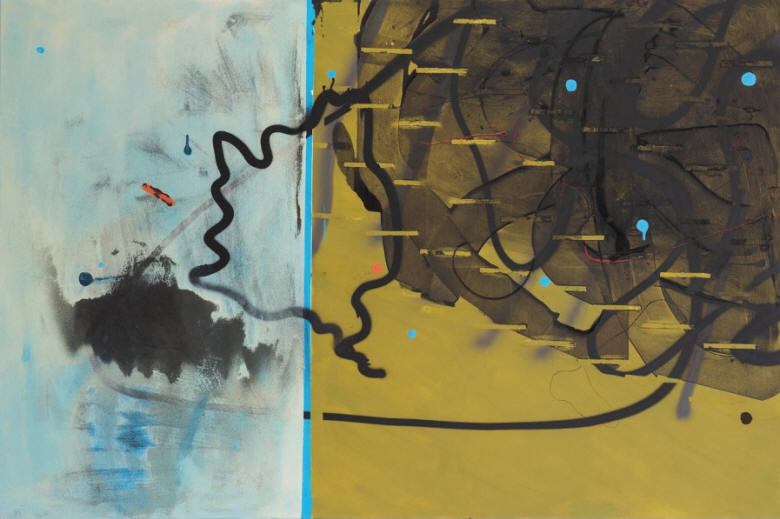
Deep Glade Walk acrylic on canvas
100x150cm
The genre of using digital mapping
technology in art is relatively new, in the book Walking and Mapping by
Karen O’Rourke, case studies include work by artist Jeremy Wood who uses
customised GPS drawing as a medium, “Drawing with ourselves as we
move”-Digital Trails. I am interested in cultures that map the world in
completely alternative modes and materials, such as the Marshall Island
Stick Charts which represent a system of mapping ocean swells encoded
using stick and twine from coconut trees, Island locations were
indicated by shells.
Using my own GPS App I ventured away from Waiheke and took the ferry to
Rangitoto. This iconic volcanic Island near the shores of Auckland is a
strongly visible landmark with its distinctive symmetrical cone like
hill which rises 260 metres out of the sea. Rangitoto is Maori for
‘Bloody Sky’ and was active around 600 years ago. Over the years
windswept seeds have made their home on this unforgiving volcanic lava
which has gradually become more fertile over hundreds of years. It now
has the largest forest of Pohutukawa trees in the world and I walked
through this dense woodland on a pathway around to the lava caves
eventually reaching the summit where the views from the top were
breathtaking and inspiring. This walk had a strong materiality and the
lava terrain reminded me of my own interest in the importance of the
ilmenite powder which I use in many of my paintings. For the Rangitoto
paintings I applied the ilmenite powder onto the canvases which reminded
me of the volcanic lava dust evident there. ‘Crater Path’, ‘ Midnight
Summit’ and ‘Summit Maea’ have materialised out of my direct experience
of this Island. ‘Crater Path’ is a painting that I physically wrestled
with through several incarnations hidden behind layers of opaque paint
and mineral particles. I felt instinctively that this painting needed to
be tonally rich, echoing the wrought grittiness of the terrain.
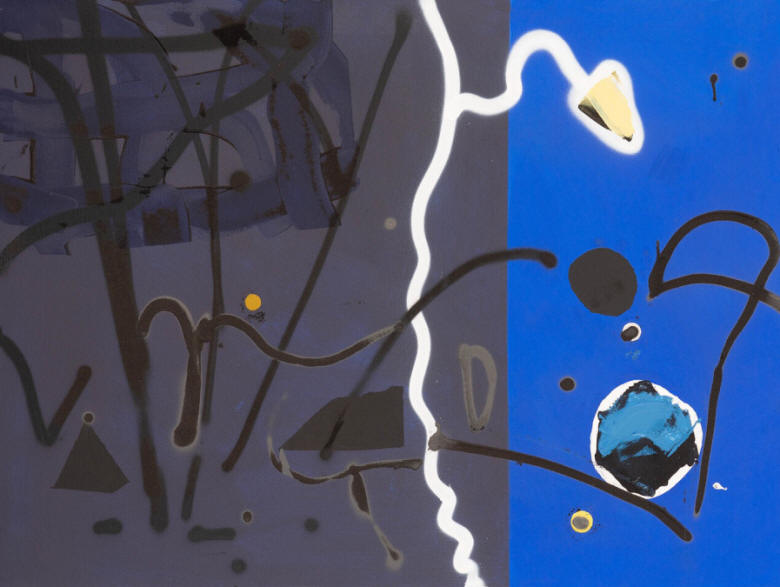
Midnight Summit acrylic on canvas
76x102cm
 Crater Path acrylic on canvas 76x102cm
Crater Path acrylic on canvas 76x102cm
At the north eastern tip of Waiheke Island at the end of an unmade road
which was the colour of honeycomb clay I walked to Stony Batter. This
historic defence installation is sited within a 50-acre reserve where
there are many boulders scattered in clusters in and around the steep
hills. The stones themselves are covered in a patina of lichen and some
boulders are broken through fracture lines while others lie in piles of
rock flakes. The shapes of these individual stones and the clear quality
of light and luminous colour has found its way into the paintings in the
studio. ‘The Honeycomb Clay Road’, which is a large key diptych painting
made after visiting the reserve has been heavily inspired by the
atmosphere and mood of the area.
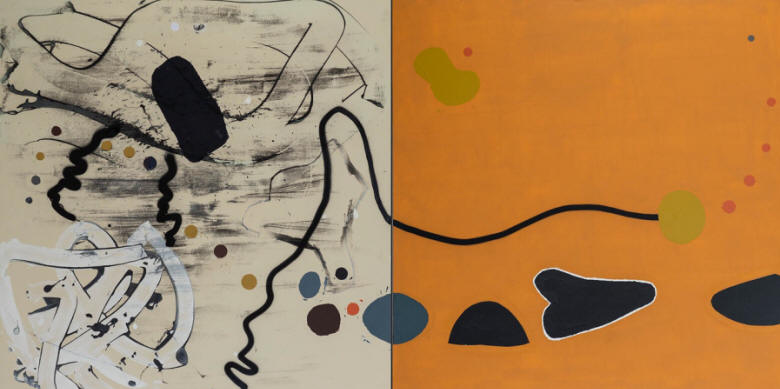 The Honey Comb Clay Road acrylic on
canvas 120x240cm
The Honey Comb Clay Road acrylic on
canvas 120x240cm
‘Ocean Moon Ara’ was one of the first paintings I made, with its fine
vertical cream coloured line separating the two blue colour field
passages, the left section perhaps can be identified as sky and the
right two thirds of the painting – ocean. I like to think that the thin
vertical line is not stationary but is set in motion scanning from left
to right like an archaeological scanning device mapping its way around
the topography. I pour, move brush and rubber blade around the canvas
often wet on wet to emphasise fluidity and movement, like the movement
of the human body walking through colour. Often I finish the paintings
with more precise punctuation marks in the form of dots, suggesting
multiple readings- the location of the moving walker perhaps, the
satellites orbiting above the earth, or planets and stars all of which
are visual devices to take the eye around the painting.
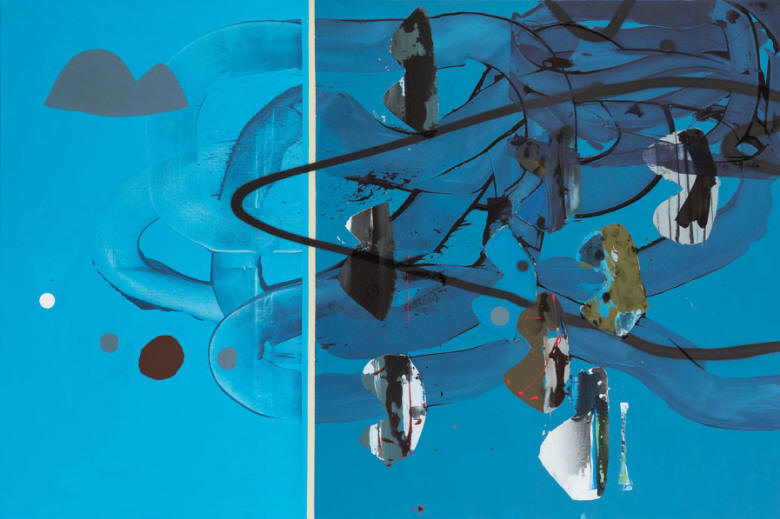
Ocean Ara acrylic on canvas 100x150cm
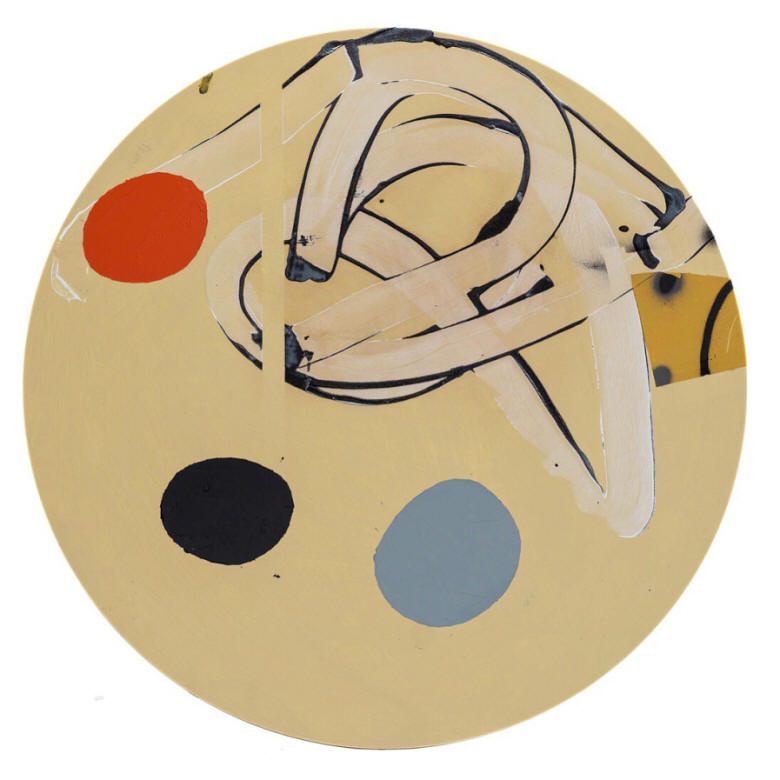
Sand Loop acrylic on canvas 80cm
Finally the inspirational line of ‘The Shape of the Walk’ has come full
circle.
This residency on Waiheke Island has been pivotal to my practice, a
sense of renewal and a deeper focus has manifested itself within me not
only to map the terrain but to own it in my paintings.
For more information see
https://marksurridgewaihekeartresidency.com/ |






